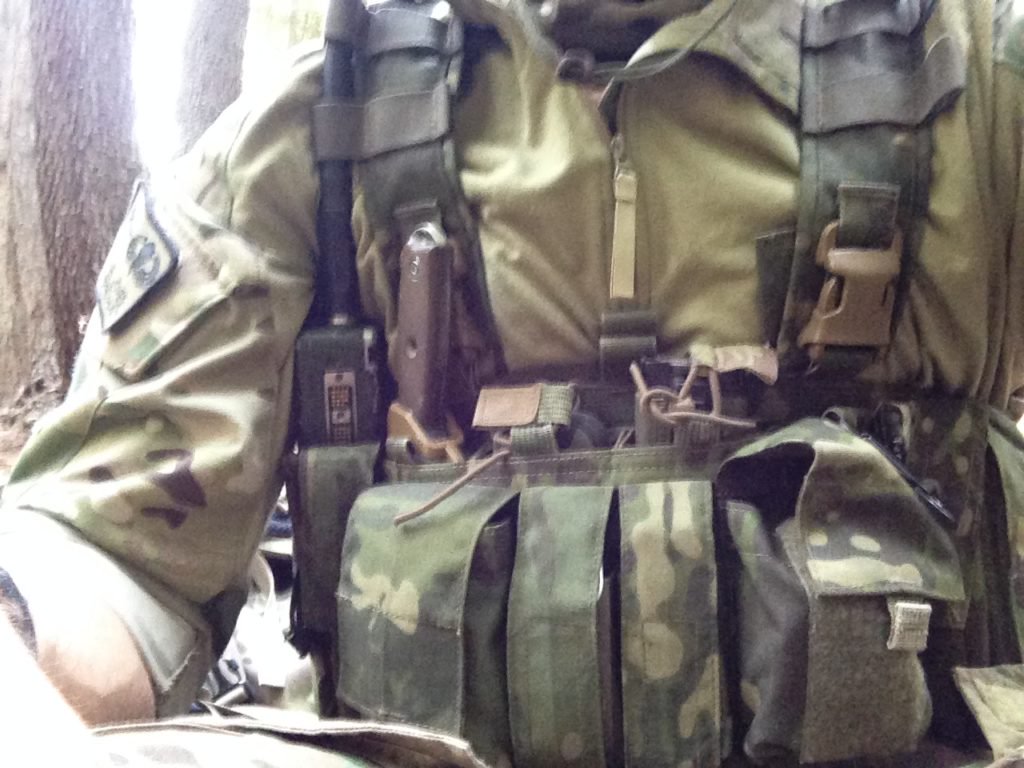
*The author has chosen to remain anonymous for operational security reasons*
I’m not a fan of having equipment on my belt line. It impedes movement, and gets in the way during awkward shooting positions or when getting into observation spots. As a SERE instructor for the military, I have quite a bit of minimal gear that I need to carry in order to fulfill my job effectively.
Over the past couple of years, I’ve modified the way that I carry this gear through trial and error. Most of my time in the field is spent doing either hard work (felling trees, chopping wood) or doing some type of squad-level movements in simulated non-permissive environments. What I’ve found that works best for me is wearing a light well-constructed chest rig to carry most of my essential need-to-get-to equipment and the rest goes in my field ruck.
 What I like most about using a chest rig is that I can easily drop my ruck at a cache point and move to an objective and be confident that I have the necessary gear on me to survive or be able to complete an objective. My chest rig loadout is centered almost entirely around a combat evasion and survival model and in a modified loadout for light recce activities.
What I like most about using a chest rig is that I can easily drop my ruck at a cache point and move to an objective and be confident that I have the necessary gear on me to survive or be able to complete an objective. My chest rig loadout is centered almost entirely around a combat evasion and survival model and in a modified loadout for light recce activities.
There are many wonderful chest rigs out on the market today and I’ve tried most of them and or I’ve seen fellow instructors use them. For the past 6 months, I’ve been using the Mayflower Gen IV Chest Rig. I’ve tried split front chest rigs but I’ve found that much of the valuable real estate up front is taken up and I have to shift my equipment to the side where it will interfere with my ruck straps. I’ve always been a fan of mayflower rigs but that isn’t to say that there aren’t other chest rigs out there that will suit you just fine. In general, I’d advise staying with a non-front-split chest rig, which is just my humble opinion based on my experiences.
Setting It Up For Combat Survival
In my combat survival chest rig, I have it set up as follows for survival. The Leftmost pouch is typically a small Individual First-Aid kit put together by the Counter-terrorism Institute of America (any small IFAK will do well). Moving across the front row moving left to right I have one yellow and one IR chemstick, a military-issued lensatic compass lanyarded off to me, a US pocket knife, Leatherman wave (same one issued to me when I started training, great little tool), Princeton LED headlamp, 5 lines of 10ft 550 cord, firesteel, and a PRC-152 radio on the furthermost right-hand side (Sometimes on the left swapped with the IFAK when necessity rears its ugly head).
On the innermost pouches designed for magazines, things change up depending on what I’m doing. For survival, left to right is surefire g2 light and Benchmade folding knife, Garmin eTrex 30 (has topo maps of the entire world, if I don’t have a map of the area I’m good to go.), MS2000 IR strobe, and finally my trusty ESEE 4 knife (Same one issued at the beginning of training, hell of a knife). And on the strap of my chest rig or on my wrist I also have my Garmin Foretrex 401 for most of my navigation needs.
In a light Recce role, I swap out the left 3 back magazines pouches for STANAG magazines. The Garmin eTrex 30 and other items get moved to the pack as they are typically not mission essential. The lensatic compass is my main navigation tool along with a map. If no map is available I use the Garmin eTrex 30’s topographic maps and plot my destinations. The Garmin Foretrex 401 is used to navigate and check headings as necessary.

This setup will not work for everyone and is very specific to my job but I hope it at least serves as a primer for those of you looking to set up a light survival/recce rig. A chest rig keeps you light on your feet and your hips free to use those kidney belts on your ruck. As always the man is what matters and not the gear. Nevertheless – great gear never hurts.
Stay tuned to The Gear Bunker and be a part of this all veteran-owned website. And be sure to subscribe to our Facebook, Instagram, and YouTube channels. Sign up to be notified on YouTube ensuring you’ll know immediately when new content is uploaded.
Check out our new Affiliate Partner Page.
Visit our Amazon Storefront for more related items.

Where’s your water